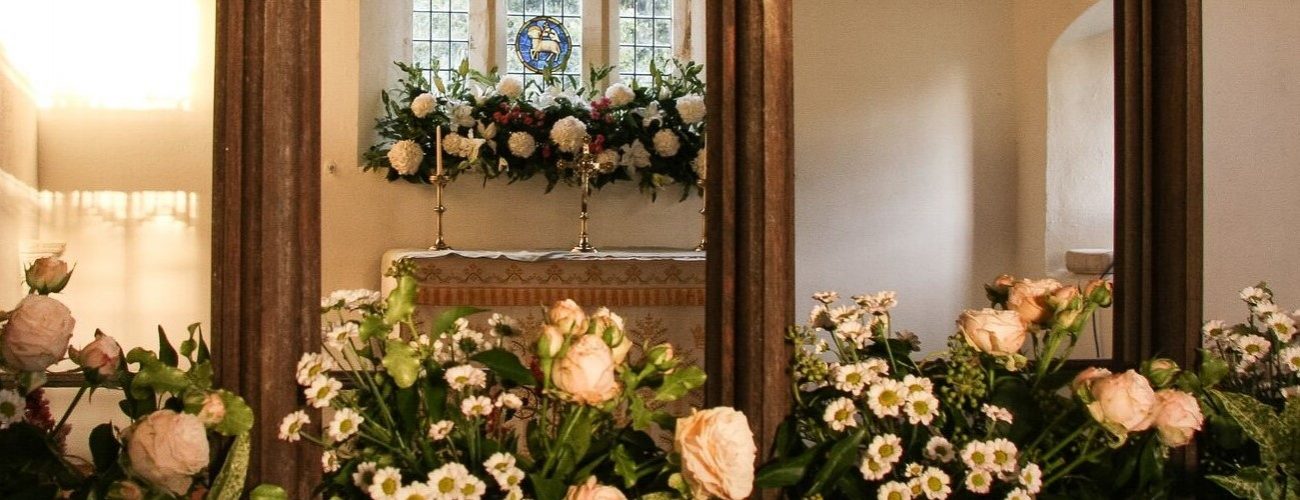
Welcome to St Nicholas
Berwick Bassett
This church is now what is known as a “redundant church” in the care of the Churches Conservation Trust and services are only held here no more than 8 times a year.
Virtually unchanged since it was built over 450 years ago, it offers a rare glimpse of a church beautiful in its simplicity.
Regular Services
History
A modest, simple and secluded church, situated by a farmyard to the north of Avebury and near the Ridgeway, this church is essentially fourteenth century in origin, although the font suggests an earlier structure. The interior is light and simple; its nave is medieval, as is the chancel, though it was later rebuilt in brick with the old window openings retained. The low tower has a Victorian top and there is a pretty fifteenth-century screen inside the church.
The name of Berwick Bassett village comes from Alan Bassett, who held the manor of Berwick in 1211. It may have been Alan who built the first church here, in the shadow of Hackpen Hill, or perhaps it was the prebend of Calne, who owned the parish tithes. The pretty 15th-century manor house where Alan’s descendant’s lived stands just south of the church.
St Nicholas has a nave, chancel, and south tower which doubles as the porch. The chancel was heavily remodelled in the 18th century, but several medieval windows were reused, including a small quatrefoil window opening high on the east wall. The building is partly built of stone and partly of brick; the latter being the result of restoration work by TH Wyatt in 1857. The font is early medieval, probably 13th century, in which case it predates the church. This suggests that there was an earlier building on the site, and the font was reused when the current church was built. The interior also features a 15th-century wooden screen. One of the most interesting features is a small 15th century brass to a priest, set into the chancel floor. The inscription says ‘Here lyeth William Bayly, thus it pleases the Lord. He bequeathed to the Church one hundred shillings always to remain. He died the 5th before the ides of November, A.D. 1427’. The tiles that surround the brass are by the famous firm of Minton.
On the north chancel wall is a tablet to Henry Webb (d. 1776), who left money for a teacher to educate the children of local poor families. Inside the door is a grave slab to Frances Cripps. The inscription tells us that she ‘departed this life in prayer upon her knees’. Near the church are standing stones converted to serve as gateposts. The church information booklet states that ancient sarsen stones have been used here as grave markers in the past.
Pilgrim History
On the exterior of the church visitors may find the sundial on wall of church and pilgrim crosses carved in doorway and lintel. A St Andrew’s cross was discovered and next to it a crude beginning of a Medieval Map of the Cosmos or sundial – someone began this carving and was interrupted. On the walls and lintels around the back of the church we find more Pilgrim crosses, and on the stone adjacent one window a remarkable carving of what at first glance might be seen as a Bishop or skirted figure. As the windows date from 1450s -60s it is likely to be a pilgrim marking. Sadly some of the pilgrim and Templar crosses have been deliberately defaced.
It is interesting to note the proliferation of Palm leaves on Norman font again pointing to our pilgrim history. The door lock is original 1215 or thereabouts and there is ample evidence to support the supposition that pilgrims would have come in that way including a St Andrews cross on window ledge. Very early and crudely carved crosses with dots near font plus Andrews cross indicates that in all likelihood this too was a place of overnight hospitality. A single aisle church would not usually have a side chapel with the exception of a church used for pilgrimage. By using a side altar the High Altar was kept holy in a dormitory church for wayfarers.
Local Organisations
Berwick Bassett elects a joint parish council with the adjacent parish of Winterbourne Monkton. It is in the area of Wiltshire Council unitary authority, which is responsible for all significant local government functions.
All meetings are open to members of the public to find out the dates and to find out about what the council does, please visit our website.
